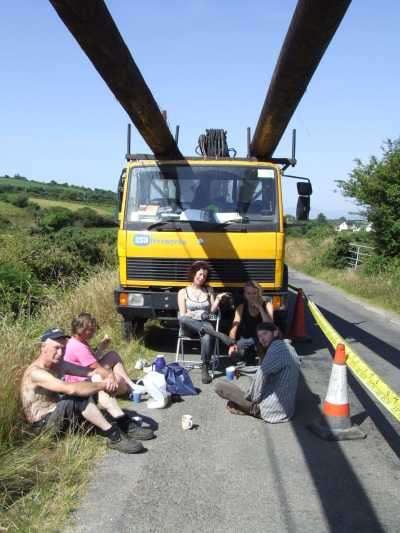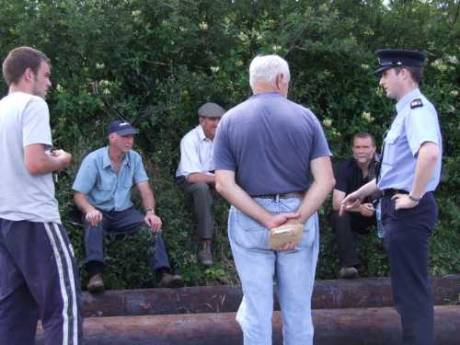ESB moves the goalposts but not the pylons as Protest Group about to issue proceedings for breaches
 cork |
environment |
news report
cork |
environment |
news report  Wednesday August 02, 2006 15:07
Wednesday August 02, 2006 15:07 by Quentin Gargan - Bantry Concerned Action Group
by Quentin Gargan - Bantry Concerned Action Group bantrypylonprotest at eircom dot net
bantrypylonprotest at eircom dot net
Costs awarded against the ESB but injunctions granted
At the High Court on Monday 31st July, members of Bantry Concerned Action Group were about to issue proceedings under section 160 of the Planning Act against the ESB, arguing that the powerline proposed in Bantry is currently an unauthorised development.
The proceedings were providing a welcome respite for protesters to so far have successfully blocked the ESB from continuing work along the route of the powerline. Farmers along the route assisted by members from the Solidarity Camp had successfully blocked numerous efforts by the ESB to off-load poles, bring diggers on-site etc. The exercise, according to the ESB, cost them €15,000 each day, with virtually no results for all their efforts. At time of writing, all machinery and equipment has been removed from the area.
On Friday 28th July, Judge Frank Clarke had withheld a number of injunctions sought by the ESB against members of Bantry Concerned Action Group (BCAG) who had been blockading their lands. In that hearing, Judge Clarke said that there were planning issues to be dealt with before he could serve injunctions. He gave the group until Monday to issue proceedings regarding these matters. Things were looking up for the group....
The powerline was to provide grid connection to a windfarm owned by local businessmen Bob Murnane and Denis O’Shea. In some cases the powerline passes within 25m of houses and farmers are concerned about links between proximity to powerlines and leukaemia in children.
An affidavit in earlier proceedings on behalf of the windfarm developers, said that there has been an agreement to bury the line for four landowners in the Colomane Region. The group claimed that this is in breach of the planning consent granted by An Bord Pleanala which states that the development must be built exactly in accordance with the plans lodged. The group also claimed that other proposed changes to the route of the powerline which were not in the original planning application are an unauthorised development.
In lay terms, if you get permission to build a three-storey house, you can’t just build two storeys, even though the smaller house may have less visual impact – you must re-apply. The ESB had failed to do this.
HOWEVER, the ESB arrived in to Court with two Senior Counsel and one Junior Counsel. In addition to having Joe Christle B.L., and Mel Christle S.C., they also brought James Macken S.C., with them.
James Macken informed the Court that following on from the decisions made by Judge Clarke on the previous Friday, the ESB had decided that it was no longer going to follow any alternative routes or means of routing wires underground and was therefore giving a solemn Undertaking to the Court that it would now build the line for which it had obtained a grant of Planning Permission, strictly in accordance with that permission.
In other words, the ESB was no longer going to have part of the line underground and parts of the line moved distances of up to 150 metres plus from the route for which it had obtained a Grant of Planning Permission. This would appear to mean that the ESB and the windfarm developers were now going to renege on their agreements with a number of landowners to put 4km of the wire underground and to re-route the line in some areas.
This would appear to mean that the ESB may now resume the project, provided that they stick strictly to the route originally agreed. It remains to be seen if they will recommence the project. We may be calling on you for help if they do. There are 26 farms along the route that need protection!
Planning file in Cork County Council incomplete
In the meantime, the group is to make enquiries with Cork County Council to find out why a substantial number of important documents are missing from the planning file for the powerline. A letter from Bob Gunkel, Senior Planner at Cork Co. Council was submitted as an exhibit in last weeks injunction proceedings. The letter refers to two meetings in February he had with the ESB. Neither this letter, nor the documentation referred to in it are on the planning file. Nor is there any record on the file of these meetings taking place or of this documentation being in existence. As late as last Thursday evening none of this information was on the file, even though the group understands that by law all of this documentation is required to be on the file.
The letter grants approval to a number of amended routes , some of which are outside the scope of the original planning consent.
“We are entitled to rely on the planning file to tell us where the ESB has permission to erect pylons and poles, said Mr. Casey, solicitor for the group “how are we expected to have any confidence in the role of our local planning authority given these failings?”
“It is utterly extraordinary that a planner of Mr. Gunkel’s experience and standing would not see fit to put these letters and associated documentation on the file or to put a note on the file saying that he was dealing with it” he added.
FURTHER INFORMATION
BCAG website with map, reports etc. ……… http://www.bantrypylonprotest.com/
BACKGROUND INFORMATION
The powerline is to provide a grid connection for a windfarm being developed by local businessmen Bob Murnane and Denis O’Shea. Bantry Concerned Action Group which represents the farmers is not protesting about the windfarm, but wants the entire powerline put underground as is common practice throughout Europe.
In the Netherlands, 100% of such lines are underground, in Belgium, 85%, in UK 81% and in Germany Denmark and Sweden it is above 50% with the trend being for more cables to go underground in recent installations.
By comparison, the national grid in Ireland comprises over 5,800 km of high and medium voltage lines and cables. There is approximately 75 km (1.3%) of underground cables principally at 220kV in urban areas of Dublin.
(Source – EU Background Paper Undergrounding of electricity lines in Europe, 10th Dec. 2003)
Pricing for wind energy
The Commission for Energy Regulation (CER) has set a price for electricity from windfarms at 5.75 cents per unit. This is lower than the price paid for electricity from gas and many other sources, and keeps the margins for windfarm operators very tight.
BCAG believes that CER should establish a higher price for electricity specifically to fund placing lines underground. Already there are higher prices between 8c and 9c per unit for electricity from offshore wind farms because of the higher construction and transmission costs. While the group supports green energy, it believes that the ESB is trying to provide wind energy at a price that is lower than other EU countries and doesn’t provide for the true cost of the infrastructure required.
In relation to the Bantry project, based on European costs the additional cost to put cables underground would be between €1.5M and €3M. A further ¼ to ½ cent per unit would cover this cost. There are long-terms savings as the maintenance cost of buried powerlines is estimated to be 10% of the cost of maintaining overhead lines, and there are reduced power losses in underground cables.
Health Risks
A report published in the British Medical Journal by Gerald Draper, Tim Vincent, Mary E Kroll & John Swanson studied 29,000 children with cancer, 9,700 of them with Leukemia. They assessed the distance these children lived from power lines. They found that even at distances up to 200m from pylons, the incidence of leukemia in children was 64% higher than in those living over 600m from a pylon. (British Medical Journal, June 4th 2005). See http://www.bantrypylonprotest.com/wp-content/uploads/bm...1.pdf
Other smaller studies have suggested that children living within 25M of a power line were at twice the risk.
Possible Causal Link
Separate research into particle ionisation is quite compelling. Denis Henshaw of the University of Bristol has shown that the electrostatic fields generated by cables polarise droplets of water, which are then attracted to the cables. Pollutants such as sulphur dioxide also become ionised. According to Henshaw, that's the hissing you hear near power lines, and the ions then dissolve in the water droplets.
Henshaw speculates that these ions might also cause disease by being inhaled and retained in the lungs. He has no direct proof that there is a health problem, but quotes a study by Beverly Cohen of the New York University Medical Center. In 1998, Cohen found that electrically charged aerosols are six times as likely to adhere to the lining of the lung than neutral particles. (New Scientist, 11th Dec. 1999). See http://www.bantrypylonprotest.com/?page_id=17

Poles get to stay on the truck for now. At least the weather was nice.
